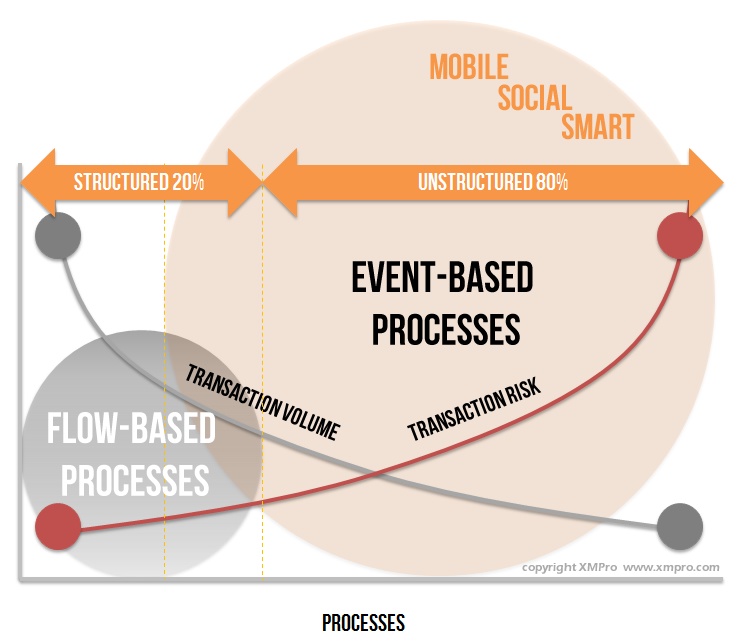I introduced the Unpredictable Process graph in a previous blog post. It is actually more of an “Unpredictable Operational Risk” curve as organizations come to realize that they understand more of their high volume transactional processes than of the low volume human-centric processes. They have process controls in their “Systems of Transaction” to manage transactional risk. They are finding that it is the unpredictable processes that rely on people’s knowledge, experience and intuition that pose high operational risk and most of it has limited process controls.
Major decisions are communicated in emails with no “decision trails”, limited supporting documentation or business intelligence and many of these decisions rely on someone’s experience to take the right action. There are no pre-defined workflows for this. Most of these tasks are done by “knowledge workers” that are on the road, in meetings and different “hot seats” every day. We can’t map out their work in clear linear flow diagrams with all the decision options to handle exceptions. They often work within a governance framework, but make decisions that impact the outcome of a process. They are at the heart of the business operations.
Improving operations means improving the way these people work. One of the worst mistakes that I have seen is to try and map what these knowledge workers do, wrap it in some business rules, and try to turn it into a pre-defined workflow. I appreciate the value of business rules, but it should support and guide them, not try and automate their decisions. We need to make business operations smart or “intelligent” by providing the best decision support and social collaboration that we possibly can and then deliver it in a way that works the way these knowledge workers work. We still need to do this within the legal and organizational governance frameworks that these decisions are made in.
So let’s look at a simple example.
Let’s say you have a production facility where you make and service large complex machines. There is a job management system in your ERP solution that creates job cards, issue spares from inventory and does billing etc. for the repair work that your company does. It is very structured and easy to define and control the process flow. The exceptions are handled with simple workflow and some of that is in the ERP solution that you bought. It doesn’t require mobility or social discussions every time a job card is printed.
In that same repair workshop you now get a warranty claim on a $250,000 unit that came from your production facility. Decision time. You rely on the experience and knowledge of your people to make the right decision. So what is the RIGHT decision? Your business rules may prescribe a certain set of actions but the real answer is “IT DEPENDS”. It depends on who the customer is and what their LTV (Life Time Value) is. We get that from the CRM and embed it as Process Intelligence in the “Next Best Action” advice that we are constructing for the assessor (case manager) to make a decision on the outcome of the warranty claim. We also include information on similar failures from the same customer or product range. It helps making smarter decisions. The assessor may want to have a quick discussion with the sales representative for that account to find out what big deals are in the pipeline and include the COO that will have to justify or support the decision later. Someone will have to authorize this, either way. The COO is overseas on a mobile device and his feedback is now part of the decision trail. The process is social and mobile. The process is supported by business intelligence and data from inside and outside the organization. The process is smart.
The operational process is now intelligent, irrespective of the warranty outcome. There is no RIGHT answer. There is no RIGHT PATH. It differs on a case-by-case basis. That is the nature of knowledge worker processes.
The example also illustrates the difference in the tools and support that knowledge workers need. When we create the job cards for the production line from the ERP application we need a server and a structured process flow. High volume, low transactional risk. When we do the warranty claim we need to be able to work anywhere (mobility), we need collaboration (social) and we need support information (smart) to make informed decisions.
Intelligent Business Operations is about increasing the overall Productivity of an organization. But productivity is not just about efficiency (doing things faster), it is also about effectiveness (doing the right things). The best productivity gains are achieved when you first do the right things before you do them fast. For knowledge work the challenge is all about doing the right things. It is about being connected, being social and being smart.
In my next blog post I’ll explain why it is ok for a 6 step process to have 46,656 potential paths and why workflows don’t work for these unpredictable processes.









